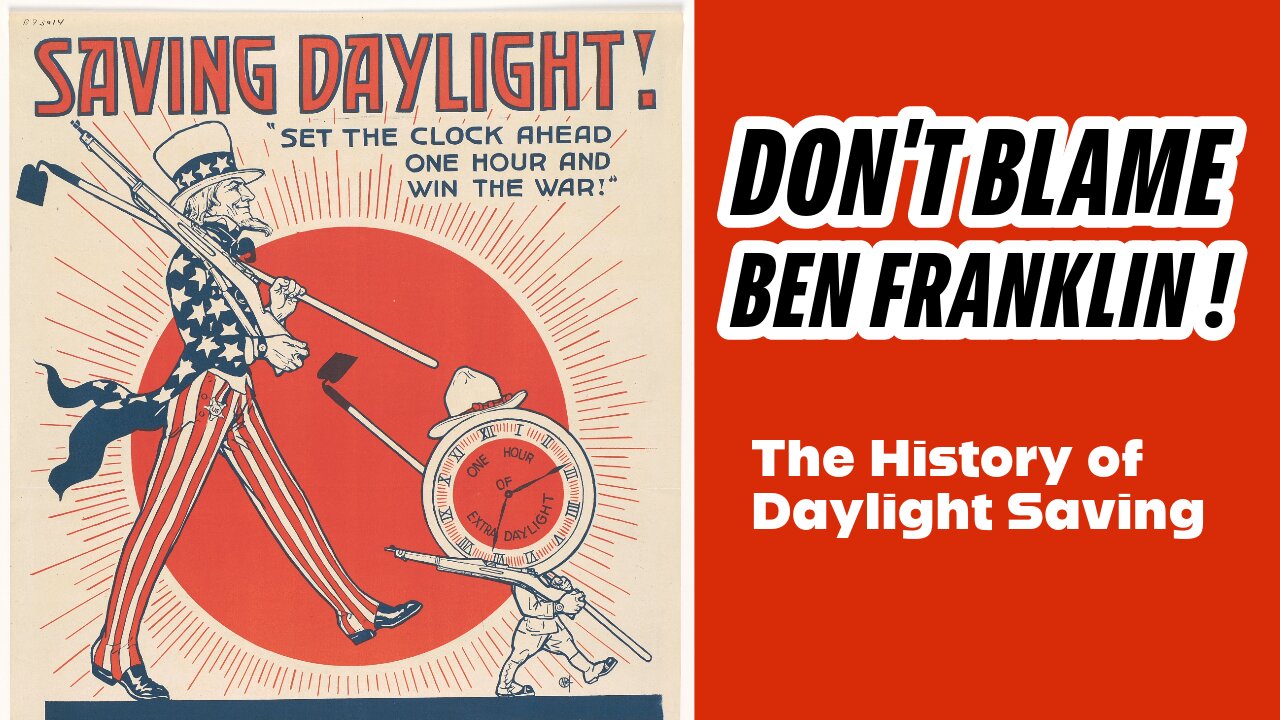Premium Only Content

Don't Blame Benjamin Franklin! The History of Daylight Saving
The biannual adjustment of clocks for daylight saving time is a frustration for many, and for those that hate the practice there appears to be no hope that it will end anytime soon. Let’s look at how this all began.
Daylight savings is often linked to Benjamin Franklin, but the roots of this controversial practice really lie in attempts at energy conservation during war times.
Franklin playfully suggested the idea in 1784, sarcastically proposing that the party-loving citizens of Paris could save on lamp oil by going to bed earlier. However, it only gained serious consideration in New Zealand and England much later.
George Vernon Hudson, a New Zealand entomologist, proposed the idea in 1895 because he wanted to maximize daylight for his insect collecting hobby. William Willett, an English builder, also championed daylight saving time after his observations during a 1905 horseback ride that many residents of London were still asleep while the sun was rising. An avid golfer, Willett also disliked cutting short his round when the sun set.
Willett published "The Waste of Daylight" in 1907, proposing setting clocks forward by 80 minutes in spring and reversing the process in the fall. Despite initial resistance, he gained support for the idea, but passed away in 1915, a year before it saw widespread adoption.
The impetus for its adoption came about during world war one when governments were concerned about conserving energy.
Germany led the way in Europe, formally adopting daylight savings time on April 30, 1916. The rationale was indeed to conserve coal by optimizing daylight usage and reducing the need for artificial lighting. The idea was that by shifting the clocks forward during the longer days of summer, people would use less electricity for lighting in the evening.
Austria-Hungary, the United Kingdom soon followed suit, and the United States also introduced the concept in 1918.
Daylight savings continued to be adopted during war times and intermittently ceased thereafter. It regained popularity during the 1970s energy crisis and began the road towards its current permanent presence.
But research on the energy-saving effects of daylight savings has produced mixed results. The impact can vary depending on factors such as geographical location, climate, and technological advancements. Some studies also suggest that the reduction in lighting costs during the extended daylight hours is offset by increased energy consumption in other areas, such as heating and cooling, as well as transportation.
As societies have evolved and technology has advanced, the primary reasons for adopting daylight saving have expanded to include factors like increased outdoor activities, economic benefits, and potential reductions in traffic accidents.
It has been argued that farmers enjoy the ritual, but in fact they largely oppose the schedule, saying that it adds to challenges of farming.
Like Hudson, the New Zealand bug collector, daylight saving benefits office workers – by increasing available light for after work activities.
More recently there has also been more attention on the health consequences of changing the clock, which include disrupted sleep and stress, along with increased risks of strokes, heart attacks, and traffic accidents.
Efforts to end daylight saving have gained momentum, with the European Parliament voting to abolish it in 2019. However, member states have delayed decisions on how to move forward. In the United States, the Senate passed legislation in 2022 for a permanent shift to summer time starting in 2023, but progress stalled in the House of Representatives.
Today, discussions continue about the relevance and potential impacts of daylight saving on energy savings and public well-being, but for those opposing the practice there seems to be little light on the horizon.
-
 40:10
40:10
ZeeeMedia
13 hours agoFDA Memo: "Covid-19 Vaccines Have Killed American Children" | Daily Pulse Ep 153
12.4K26 -
 LIVE
LIVE
Pickleball Now
5 hours agoLive: IPBL 2025 Day 2 | High-Intensity Matchups Continue in the Indian Pickleball League
228 watching -
 15:11
15:11
itsSeanDaniel
1 day agoAngry Liberal Defends ILLEGALS, Then Gets CALLED OUT For It
40.1K24 -
 10:32
10:32
Actual Justice Warrior
2 days agoColorado School FORCES Girl Into Bed With Trans
23K27 -
 18:14
18:14
Nikko Ortiz
15 hours agoMost Painful Internet Clips...
69.5K12 -
 2:08:21
2:08:21
Side Scrollers Podcast
20 hours agoHasan Dog Joke Gets Streamer BANNED + Great Reset 100% CONFIRMED + More | Side Scrollers
53.7K14 -
 11:35
11:35
MetatronGaming
3 days agoYou Won't Believe Your Own Eyes..
17.8K1 -
 20:22
20:22
The Pascal Show
10 hours ago $1.26 earnedARE THEY IGNORING HER?! Is The White House & FBI Ignoring Candace Owens' A**assination Claims?!
12.4K6 -
 1:24:49
1:24:49
omarelattar
2 days agoThe $100M Sales Expert: “The Psychology of Selling To Anyone!” (High Ticket, Phone & Ai Secrets)
41.5K3 -
 18:36
18:36
GritsGG
16 hours agoTrios is BACK! Slamming Lobby w/ Mr. Bobby Poff!
17.4K